北京外国语大学:《投资科学 Investment Sciences》课程教学资源(课件讲稿)Part II Single-Period Random Cash Flows
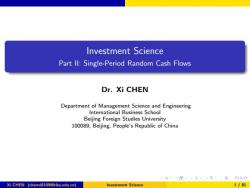
Investment Science Part Il:Single-Period Random Cash Flows Dr.Xi CHEN Department of Management Science and Engineering International Business School Beijing Foreign Studies University 100089,Beijing,People's Republic of China 4口,40+4立4至,三)及0 Xi CHEN (chenxi0109@bfsu.edu.cn) Investment Science 1/81
Investment Science Part II: Single-Period Random Cash Flows Dr. Xi CHEN Department of Management Science and Engineering International Business School Beijing Foreign Studies University 100089, Beijing, People’s Republic of China Xi CHEN (chenxi0109@bfsu.edu.cn) Investment Science 1 / 81
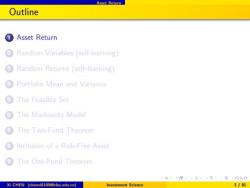
Asset Return Outline ①Asset Return Random Variables(self-learning) Random Returns (self-learning) Portfolio Mean and Variance The Feasible Set ⑥The Markowitz Model The Two-Fund Theorem Inclusion of a Risk-Free Asset The One-Fund Theorem 4口40+4三4至,至)只0 Xi CHEN (chenxi0109@bfsu.edu.cn) Investment Science 3/81
Asset Return Outline 1 Asset Return 2 Random Variables (self-learning) 3 Random Returns (self-learning) 4 Portfolio Mean and Variance 5 The Feasible Set 6 The Markowitz Model 7 The Two-Fund Theorem 8 Inclusion of a Risk-Free Asset 9 The One-Fund Theorem Xi CHEN (chenxi0109@bfsu.edu.cn) Investment Science 3 / 81
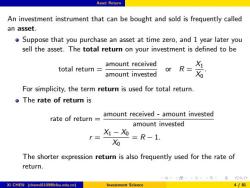
Asset Return An investment instrument that can be bought and sold is frequently called an asset. o Suppose that you purchase an asset at time zero,and 1 year later you sell the asset.The total return on your investment is defined to be amount received total return X amount invested or R=X For simplicity,the term return is used for total return. o The rate of return is rate of return amount received-amount invested amount invested I= X1-Xo Xo =R-1. The shorter expression return is also frequently used for the rate of return. )Q0 Xi CHEN (chenxi0109@bfsu.edu.cn) Investment Science 4/81
Asset Return An investment instrument that can be bought and sold is frequently called an asset. Suppose that you purchase an asset at time zero, and 1 year later you sell the asset. The total return on your investment is defined to be total return = amount received amount invested or R = X1 X0 . For simplicity, the term return is used for total return. The rate of return is rate of return = amount received - amount invested amount invested r = X1 − X0 X0 = R − 1. The shorter expression return is also frequently used for the rate of return. Xi CHEN (chenxi0109@bfsu.edu.cn) Investment Science 4 / 81
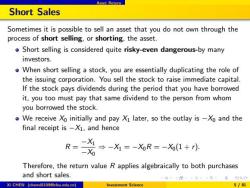
Asset Return Short Sales Sometimes it is possible to sell an asset that you do not own through the process of short selling,or shorting,the asset. o Short selling is considered quite risky-even dangerous-by many investors. o When short selling a stock,you are essentially duplicating the role of the issuing corporation.You sell the stock to raise immediate capital. If the stock pays dividends during the period that you have borrowed it,you too must pay that same dividend to the person from whom you borrowed the stock. o We receive Xo initially and pay X1 later,so the outlay is-Xo and the final receipt is-X1,and hence R=-X今-X=-X%R=-X(1+) -X0 Therefore,the return value R applies algebraically to both purchases and short sales. Xi CHEN (chenxi0109@bfsu.edu.cn) Investment Science 5/81
Asset Return Short Sales Sometimes it is possible to sell an asset that you do not own through the process of short selling, or shorting, the asset. Short selling is considered quite risky-even dangerous-by many investors. When short selling a stock, you are essentially duplicating the role of the issuing corporation. You sell the stock to raise immediate capital. If the stock pays dividends during the period that you have borrowed it, you too must pay that same dividend to the person from whom you borrowed the stock. We receive X0 initially and pay X1 later, so the outlay is −X0 and the final receipt is −X1, and hence R = −X1 −X0 ⇒ −X1 = −X0R = −X0(1 + r). Therefore, the return value R applies algebraically to both purchases and short sales. Xi CHEN (chenxi0109@bfsu.edu.cn) Investment Science 5 / 81
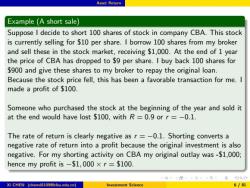
Asset Return Example (A short sale) Suppose I decide to short 100 shares of stock in company CBA.This stock is currently selling for $10 per share.I borrow 100 shares from my broker and sell these in the stock market,receiving $1,000.At the end of 1 year the price of CBA has dropped to $9 per share.I buy back 100 shares for $900 and give these shares to my broker to repay the original loan. Because the stock price fell,this has been a favorable transaction for me.I made a profit of $100. Someone who purchased the stock at the beginning of the year and sold it at the end would have lost $100,with R=0.9 or r=-0.1. The rate of return is clearly negative as r=-0.1.Shorting converts a negative rate of return into a profit because the original investment is also negative.For my shorting activity on CBA my original outlay was-51,000; hence my profit is-$1,000 x r=$100. Xi CHEN (chenxi0109@bfsu.edu.cn) Investment Science 6/81
Asset Return Example (A short sale) Suppose I decide to short 100 shares of stock in company CBA. This stock is currently selling for $10 per share. I borrow 100 shares from my broker and sell these in the stock market, receiving $1,000. At the end of 1 year the price of CBA has dropped to $9 per share. I buy back 100 shares for $900 and give these shares to my broker to repay the original loan. Because the stock price fell, this has been a favorable transaction for me. I made a profit of $100. Someone who purchased the stock at the beginning of the year and sold it at the end would have lost $100, with R = 0.9 or r = −0.1. The rate of return is clearly negative as r = −0.1. Shorting converts a negative rate of return into a profit because the original investment is also negative. For my shorting activity on CBA my original outlay was -$1,000; hence my profit is −$1, 000 × r = $100. Xi CHEN (chenxi0109@bfsu.edu.cn) Investment Science 6 / 81
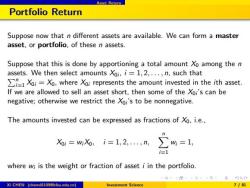
Asset Return Portfolio Return Suppose now that n different assets are available.We can form a master asset,or portfolio,of these n assets. Suppose that this is done by apportioning a total amount Xo among the n assets.We then select amounts Xoi,i=1,2,...,n,such that 1oi=Xo.where Xoi represents the amount invested in the ith asset. If we are allowed to sell an asset short,then some of the Xoi's can be negative;otherwise we restrict the Xoi's to be nonnegative. The amounts invested can be expressed as fractions of Xo,i.e., Xoi wiXo,i=1,2,...,n, ∑%=1, i=1 where wi is the weight or fraction of asset i in the portfolio. )Q0 Xi CHEN (chenxi0109@bfsu.edu.cn) Investment Science 7/81
Asset Return Portfolio Return Suppose now that n different assets are available. We can form a master asset, or portfolio, of these n assets. Suppose that this is done by apportioning a total amount X0 among the n assets. We then select amounts X0i P , i = 1, 2, . . . , n, such that n i=1 X0i = X0, where X0i represents the amount invested in the ith asset. If we are allowed to sell an asset short, then some of the X0i ’s can be negative; otherwise we restrict the X0i ’s to be nonnegative. The amounts invested can be expressed as fractions of X0, i.e., X0i = wiX0, i = 1, 2, . . . , n, Xn i=1 wi = 1, where wi is the weight or fraction of asset i in the portfolio. Xi CHEN (chenxi0109@bfsu.edu.cn) Investment Science 7 / 81
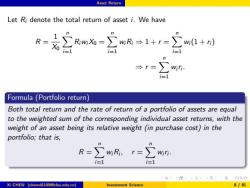
Asset Return Let R;denote the total return of asset i.We have R=无2Rw必=2R1+1-1+月 i=1 Formula(Portfolio return) Both total return and the rate of return of a portfolio of assets are equal to the weighted sum of the corresponding individual asset returns,with the weight of an asset being its relative weight(in purchase cost)in the portfolio;that is, R=∑R,=∑ =1 i=1 Xi CHEN (chenxi0109@bfsu.edu.cn) Investment Science 8/81
Asset Return Let Ri denote the total return of asset i. We have R = 1 X0 Xn i=1 RiwiX0 = Xn i=1 wiRi ⇒ 1 + r = Xn i=1 wi(1 + ri) ⇒ r = Xn i=1 wiri . Formula (Portfolio return) Both total return and the rate of return of a portfolio of assets are equal to the weighted sum of the corresponding individual asset returns, with the weight of an asset being its relative weight (in purchase cost) in the portfolio; that is, R = Xn i=1 wiRi , r = Xn i=1 wiri . Xi CHEN (chenxi0109@bfsu.edu.cn) Investment Science 8 / 81
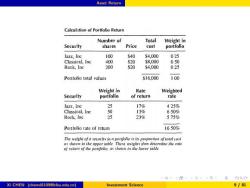
Asset Return Calculation of Portfolio Return Number of Total Weight in Security shales Price cost portfolio Jazz,Inc 100 340 s4,000 025 Classical,Inc 400 $20 $8,000 0s0 Rock,Inc 200 20 s4,000 025 Portfolio total values 316.000 100 Weight in Rate Weighted Security portfolio of return rate Jazz,【nc 25 17% 425% Classical,Inc 50 13% 650% Rock,Inc 25 23% 575% Portfolio tate of retum 1650% The weight of a securits in a poryfolio is in proportion of total cost as shown in the upper lable Theve weighus then deternine the rate of retarn of the porgfolio,as showu in the Tower table Xi CHEN (chenxi01090bfsu.edu.cn) Investment Science 9/81
Asset Return Xi CHEN (chenxi0109@bfsu.edu.cn) Investment Science 9 / 81
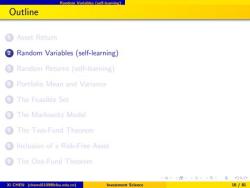
Random Variables (self-learning) Outline 19 Asset Return ② Random Variables (self-learning) Random Returns (self-learning) Portfolio Mean and Variance The Feasible Set ⑥The Markowitz Model The Two-Fund Theorem Inclusion of a Risk-Free Asset The One-Fund Theorem 4口4+4三4至,至)只0 Xi CHEN (chenxi0109@bfsu.edu.cn) Investment Science 10/81
Random Variables (self-learning) Outline 1 Asset Return 2 Random Variables (self-learning) 3 Random Returns (self-learning) 4 Portfolio Mean and Variance 5 The Feasible Set 6 The Markowitz Model 7 The Two-Fund Theorem 8 Inclusion of a Risk-Free Asset 9 The One-Fund Theorem Xi CHEN (chenxi0109@bfsu.edu.cn) Investment Science 10 / 81
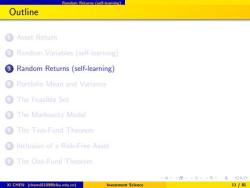
Random Returns (self-learning) Outline Asset Return Random Variables (self-learning) 3 Random Returns(self-learning) Portfolio Mean and Variance The Feasible Set ⑥The Markowitz Model The Two-Fund Theorem Inclusion of a Risk-Free Asset The One-Fund Theorem 4口4+4三4至,至)只0 Xi CHEN (chenxi01090bfsu.edu.cn) Investment Science 11/81
Random Returns (self-learning) Outline 1 Asset Return 2 Random Variables (self-learning) 3 Random Returns (self-learning) 4 Portfolio Mean and Variance 5 The Feasible Set 6 The Markowitz Model 7 The Two-Fund Theorem 8 Inclusion of a Risk-Free Asset 9 The One-Fund Theorem Xi CHEN (chenxi0109@bfsu.edu.cn) Investment Science 11 / 81
按次数下载不扣除下载券;
注册用户24小时内重复下载只扣除一次;
顺序:VIP每日次数-->可用次数-->下载券;
- 北京外国语大学:《投资科学 Investment Sciences》课程教学资源(课件讲稿)Part I Deterministic Cash Flow Streams.pdf
- 北京外国语大学:《投资科学 Investment Sciences》课程教学资源(课件讲稿)Introduction(主讲:陈曦).pdf
- 北京外国语大学:《经济数学 Mathematics in Economics》课程教学资源(课件讲稿,下)概率 Probability 第二章 随机变量.pdf
- 北京外国语大学:《经济数学 Mathematics in Economics》课程教学资源(课件讲稿,下)概率 Probability 排列组合.pdf
- 北京外国语大学:《经济数学 Mathematics in Economics》课程教学资源(课件讲稿,下)概率 Probability 第一章 随机试验.pdf
- 北京外国语大学:《经济数学 Mathematics in Economics》课程教学资源(课件讲稿,下)线性代数 Linear Algebra 第二章 矩阵.pdf
- 北京外国语大学:《经济数学 Mathematics in Economics》课程教学资源(课件讲稿,下)线性代数 Linear Algebra 第一章 行列式.pdf
- 北京外国语大学:《经济数学 Mathematics in Economics》课程教学资源(课件讲稿,下)线性代数 Linear Algebra 第一章 行列式.pdf
- 北京外国语大学:《经济数学 Mathematics in Economics》课程教学资源(课件讲稿,上)第4章 二元函数(多元函数的极值及其求法).pdf
- 北京外国语大学:《经济数学 Mathematics in Economics》课程教学资源(课件讲稿,上)第4章 二元函数(二元函数微积分).pdf
- 北京外国语大学:《经济数学 Mathematics in Economics》课程教学资源(课件讲稿,上)第4章 二元函数(二元函数的图象).pdf
- 北京外国语大学:《经济数学 Mathematics in Economics》课程教学资源(课件讲稿,上)第3章 一元函数积分学.pdf
- 北京外国语大学:《经济数学 Mathematics in Economics》课程教学资源(课件讲稿,上)第2章 一元函数微分学.pdf
- 北京外国语大学:《经济数学 Mathematics in Economics》课程教学资源(课件讲稿,上)第1章 函数、极限、连续.pdf
- 北京外国语大学:《经济数学 Mathematics in Economics》课程教学资源(教学大纲,上)Syllabus(主讲:陈曦).pdf
- 北京外国语大学:最优化方法(课件讲稿)Optimization Method(主讲:陈曦).pdf
- 华东理工大学:《货币银行学》课程教学资源(PPT课件讲稿)第四篇 金融发展与稳定 第十四章 金融与经济发展.ppt
- 华东理工大学:《货币银行学》课程教学资源(PPT课件讲稿)第三篇 金融调控 第十二章 货币政策.ppt
- 华东理工大学:《货币银行学》课程教学资源(PPT课件讲稿)第三篇 金融调控 第十三章 开放经济的均衡.ppt
- 华东理工大学:《货币银行学》课程教学资源(PPT课件讲稿)第三篇 金融调控 第十一章 通货膨胀和通货紧缩.ppt
- 北京外国语大学:《计量经济学》课程教学资源(典型例题分析)第二章 经典单方程计量经济学模型(一元线性回归模型).pdf
- 北京外国语大学:《计量经济学》课程教学资源(典型例题分析)第二章 经典单方程计量经济学模型(多元线性回归模型).pdf
- 华东理工大学:《保险学》课程教学资源(学习指导书)导论 Insurance.pdf
- 华东理工大学:《保险学》课程教学资源(学习指导书)第一章 风险与保险.pdf
- 华东理工大学:《保险学》课程教学资源(学习指导书)第二章 保险的性质、职能与作用.pdf
- 华东理工大学:《保险学》课程教学资源(学习指导书)第三章 保险合同.pdf
- 华东理工大学:《保险学》课程教学资源(学习指导书)第四章 保险的基本原则.pdf
- 华东理工大学:《保险学》课程教学资源(学习指导书)第五章 保险形态的分类.pdf
- 华东理工大学:《保险学》课程教学资源(学习指导书)第六章 财产损失保险.pdf
- 华东理工大学:《保险学》课程教学资源(学习指导书)第七章 责任保险.pdf
- 华东理工大学:《保险学》课程教学资源(学习指导书)第九章 再保险.pdf
- 华东理工大学:《保险学》课程教学资源(学习指导书)第八章 人身保险.pdf
- 华东理工大学:《保险学》课程教学资源(学习指导书)第十一章 保险单设计.pdf
- 华东理工大学:《保险学》课程教学资源(学习指导书)第十三章 保险基金及其应用.pdf
- 华东理工大学:《保险学》课程教学资源(学习指导书)第十二章 保险精算.pdf
- 华东理工大学:《保险学》课程教学资源(学习指导书)第十章 保险经营导论.pdf
- 华东理工大学:《保险学》课程教学资源(学习指导书)第十五章 保险市场结构与运作.pdf
- 华东理工大学:《保险学》课程教学资源(学习指导书)第十八章 保险市场的监管.pdf
- 华东理工大学:《保险学》课程教学资源(学习指导书)第十六章 保险市场营销.pdf
- 华东理工大学:《保险学》课程教学资源(习题与思考)各章习题与解答.pdf
